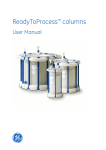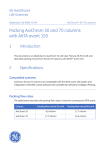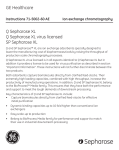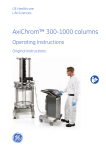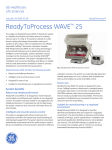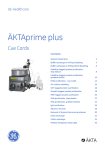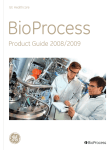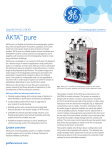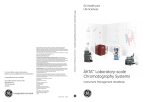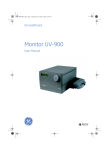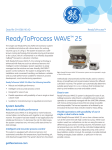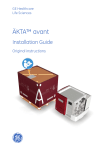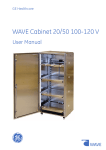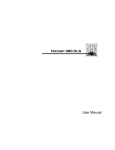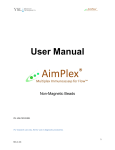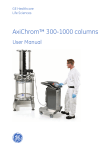Download ReadyToProcess columns - GE Healthcare Life Sciences
Transcript
GE Healthcare ReadyToProcess columns Capto S User Manual Important user information All users must read this entire manual to fully understand the safe use of ReadyToProcess columns. Safety notices This manual contains warnings and cautions concerning the safe use of the products. See definitions below. WARNING! The WARNING! symbol and notice highlight instructions that must be followed to avoid personal injury. Do not proceed until all stated conditions are met and clearly understood. CAUTION! The CAUTION! notice highlights instructions that must be followed to avoid damage to the product or other equipment. Do not proceed until all stated conditions are met and clearly understood. Note: A Note is used to indicate information that is important for trouble-free and optimal use of the product. Contents Contents 1 Introduction ..............................................................5 1.1 1.2 1.3 1.4 1.5 1.6 1.7 2 Technical specifications and characteristics ...13 2.1 2.2 2.3 2.4 3 5 General description ............................................................. 19 Properties ................................................................................. 19 Process development ......................................................... 22 Regeneration of the column between purification cycles ................................................................ 22 Storage of the column ...........................................23 Operation of the column .......................................24 5.1 5.1.1 5.1.2 5.2 5.3 5.4 6 Column testing ...................................................................... 13 Technical specifications .................................................... 13 Materials ................................................................................... 14 Chemical resistance of column parts ......................... 15 Media characteristics – Capto S ..........................19 3.1 3.2 3.3 3.4 4 General description ................................................................5 Intended use of the columns .............................................6 Scope of this User Manual ..................................................7 Handling the column upon arrival ..................................7 Identifying the main components of your column ..9 Labelling of the column ........................................................9 Safety precautions .............................................................. 10 Installation ............................................................................... 24 Removing the packaging from the column..................24 Connecting the column to a BioProcess system........25 Clearance of storage solution and equilibration of the column .................................... 26 Disconnecting the column prior to disposal ............ 27 Disposal of the column ...................................................... 27 Evaluation of the packed bed (optional) ............28 6.1 6.2 Evaluation before delivery ............................................... 28 Efficiency and As testing ................................................... 28 RTP Capto S Columns User Manual 28-9195-84 Edition AB iii Contents 6.3 7 Efficiency-testing with a high liquid velocity ........... 29 Troubleshooting .....................................................31 Appendix A Flow conversion tables..........................32 A.1 A.2 A.3 2.5 L column ........................................................................... 32 10 L column ............................................................................ 32 20 L column ............................................................................ 32 Appendix B Ordering information ............................33 B.1 B.2 B.3 B.4 iv ReadyToProcess columns ................................................ 33 Empty lab scale columns .................................................. 33 Bulk media ............................................................................... 34 Related literature .................................................................. 35 RTP Capto S Columns User Manual 28-9195-84 Edition AB Introduction 1 1 Introduction 1.1 General description ReadyToProcess™ columns are part of the ReadyToProcess platform from GE Healthcare, including chromatography and filtration products as well as other downstream solutions. ReadyToProcess columns are pre-packed, pre-qualified (by efficiency testing) and pre-sanitized chromatography columns. They are available with a range of BioProcess™ media, such as MabSelect SuRe™, Capto™ Q, Capto S, Capto adhere and Phenyl Sepharose™ 6 Fast Flow (low sub), and in the following sizes: • 2.5 L (i.d. 126 mm, bed height 200 mm), • 10 L (i.d. 251 mm, bed height 200 mm) • 20 L (i.d. 359 mm, bed height 200 mm) All wetted parts of the ReadyToProcess columns are of USP class VI, with all components traceable to their production batches. The columns are pre-packed in cleanroom (class ISO 8) environment. The columns are pre-sanitized and tested for endotoxin as well as microbiological growth and released according to specifications. Fig 1-1. ReadyToProcess columns RTP Capto S Columns User Manual 28-9195-84 Edition AB 5 1 Introduction 1.2 Intended use of the columns 1.2 Intended use of the columns ReadyToProcess columns are designed for the purification of biomolecules and specifically suited for production of material for clinical phase I and phase II studies. Depending of the scale of operations they can also be used for full scale manufacturing as well as preclinical studies. Primarily, ReadyToProcess columns are intended for use together with BioProcess chromatography systems, for example ÄKTAprocess™. The 2.5 L ReadyToProcess columns may also be used with ÄKTApilot™ systems within a limited liquid velocity range. When the column has been used it shall be disposed of as described in 5.4 “Disposal of the column” on page 27. The ReadyToProcess columns cannot be repacked. WARNING! ReadyToProcess columns must not be used for any other purpose than the intended purposes described above. WARNING! The columns are not intended for use in a potentially explosive atmosphere or for handling flammable liquids, in areas defined as zone 0 to 2 according to EN 60079-10 2002. 6 RTP Capto S Columns User Manual 28-9195-84 Edition AB Introduction 1 1.3 Scope of this User Manual This User Manual is designed as a general introduction and guide to ReadyToProcess column operation. Specifically, the manual covers: Chapter 1 General introduction, including actions to perform when the column is delivered, safety precautions and labeling. Chapter 2 Technical specifications, including principles of column function, column specifications and chemical resistance. Chapter 3 Characteristics of media, including descriptions, storage conditions and process development. Chapter 4 Storage of the column. Chapter 5 Operations, including installation, preparation of a column for use, preparations before a run, disconnecting the column and disposal. Chapter 6 Optional evaluation of the packed bed, (efficiency testing). Chapter 7 Troubleshooting. Appendix A Tables listing liquid velocities/flow rates for the different column sizes. Appendix B Ordering information. 1.4 Handling the column upon arrival The column is delivered in a cardboard container. Follow the steps described below after the cardboard packaging is opened: 1 Without breaking the plastic bags, lift the column using the handles on the top lid and remove it from the cardboard container. Place the column on a cart or a similar device. Note: The large ReadyToProcess columns are packed with an expanded ethylene insert that is easily removed before the outer package is removed, leaving the column accessible on the pallet. RTP Capto S Columns User Manual 28-9195-84 Edition AB 7 1 Introduction 1.4 Handling the column upon arrival WARNING! Appropriate transportation and lifting devices must be used when handling the larger columns, for example carts, telphers or pallet lifters. All lifting must be performed in accordance with local regulations. Two to four persons are required to lift the larger columns manually. Refer to Table 2-1. “General specifications of the ReadyToProcess columns” on page 13 for approximate column weights. 2 Check the contents against the packing list. 3 Without breaking the plastic bags, check the column for signs of damage that may have occurred during transportation. If there is any damage please contact your local GE Healthcare representative. 4 Move it to a suitable place for keeping until it is time for the column to be used. Refer to section 5.1 “Installation” on page 24 for the subsequent steps to perform. Refer to chapter 4 “Storage of the column” on page 23 if the column is to be stored for more than a limited time before usage. WARNING! Place the column where it is protected from possible damage and on an even surface where it cannot be unbalanced and fall, to cause personal injury or damage. CAUTION! To avoid contamination do not break the outer plastic bag or disturb the welded pieces of tubing mounted on the inlet and outlet TC connections of the column. See section 5.1 “Installation” on page 24. Copies of the column User Manual and the Safety Instructions leaflet are enclosed with the column. Extended Product documentation, specific for each individual column, is also included in a separate folder. 8 RTP Capto S Columns User Manual 28-9195-84 Edition AB Introduction 1 1.5 Identifying the main components of your column A ReadyToProcess column consists of the following parts, as illustrated below in figure 1-2 A B C D E F G H I J K Plug Tie rod Column label (see figure 1-3) Top lid Inlet TC connection, marked Bottom Inlet CPC sealing cap (on top of the packing valve) Outlet TC connection, marked Top Outlet Protective rim Product label Column tube Bottom lid E F G D H C I J B K A Fig 1-2. ReadyToProcess column 20L. 1.6 Labelling of the column The ReadyToProcess columns are labeled with product name, code number, lot number (referring to a series of columns produced at a specific time), ID number (identifying the individual column) and estimated expiry date, as illustrated in figure 1-3 below. The bar code (GS1-128, a total of 30 digits) contains an application identifier (90), the code number (digits 3 to 10), a second application identifier (10), lot number (digits 13 to 20), a third application identifier (21) and the ID number (digits 23 to 30). RTP Capto S Columns User Manual 28-9195-84 Edition AB 9 1 Introduction 1.7 Safety precautions The lot number and ID number ensures that the ReadyToProcess column is fully traceable to the production source. Fig 1-3. ReadyToProcess column label example 1.7 Safety precautions The columns must be used in accordance with the safety instructions and technical specifications given in this User Manual and in the separate Safety Instructions leaflet, to avoid personal injury or possible damage to equipment. This User Manual does not guarantee user safety – it is the responsibility of the user's employer to ensure safe operation and provide appropriate training. Information given in this User Manual is a suggested best working practice and shall in no way take precedence over individual responsibilities or local regulations. Great effort has been made to design and manufacture the various parts of the equipment so that it will comply with all applicable safety aspects for this type of equipment. During the operation and during other work with a column, it is always each individual's responsibility to consider: 10 • Their own and others' personal safety. • The safety of the equipment through correct use in accordance with the descriptions and instructions given in this User Manual. RTP Capto S Columns User Manual 28-9195-84 Edition AB Introduction 1 WARNING! When using hazardous chemicals take all suitable protective measures, such as wearing protective glasses and gloves resistant to the chemicals used. Follow local regulations and instructions for safe operation and maintenance of the system. WARNING! To avoid risk of possible personal injury and damage to the column and other equipment, never use the column without an appropriate pressure alarm. WARNING! Never exceed the maximum rated pressure of the column. WARNING! Do not disconnect or release the CPC sealing cap, remove the tie rods or the protective rim. Do not remove the welded tubes attached to the column inlet and outlet until the column is ready to be connected to a system and used. See 5.1 “Installation” on page 24 for instructions. WARNING! Exceeding the pressure limit may cause the tie rods to break. To avoid risk of possible injury, do not remove the top protective rim from the column. The purpose of this rim is to keep the top part of the tie rods in place in case of a breakage. WARNING! The columns are not intended for use in a potentially explosive atmosphere or for handling flammable liquids, in areas defined as zone 0 to 2 according to EN 60079-10 2002. WARNING! Wash the column before disconnecting it from a system after use to ensure that no hazardous chemicals (for example halogen-containing salt buffers) are left in the column prior to disposal. RTP Capto S Columns User Manual 28-9195-84 Edition AB 11 1 Introduction 1.7 Safety precautions WARNING! Ensure that there is no residual pressure in the column before any tubing is disconnected. 12 RTP Capto S Columns User Manual 28-9195-84 Edition AB Technical specifications and characteristics 2 2 Technical specifications and characteristics 2.1 Column testing Each ReadyToProcess column is packed and efficiency-tested, sanitized and sampled for testing endotoxin (<0.25 EU/ml) and microbiological growth (CFU<10/100 ml). The columns are ready for immediate use when delivered. The test results are presented in the Certificate of Analysis, which is enclosed in the Extended Product documentation for each column. 2.2 Technical specifications Table 2-1. General specifications of the ReadyToProcess columns 2.5 L 10 L 20 L 126 251 359 Inner cross section (cm ) 124 495 1012 Column volume (L) 2.5 9.9 20.2 200 200 200 Mechanical compression factor (%) 15 15 15 Outer height (mm) 378 388 407 Outer diameter incl. lid (mm) 195 342 484 Weight (kg) ~6 ~25 ~50 Inlet TC25 connectors, tubing i.d. 6.3 mm 0.25” 9.5 mm 0.375” 12.7 mm 0.5” Outlet TC25 connectors, tubing i.d. 6.3 mm 0.25” 9.5 mm 0.375” 12.7 mm 0.5” 4-30 4-30 4-30 4-40 4-40 4-40 Inner diameter (mm) 2 Packed bed height (mm) 1 2 Ambient temperature (°C) 2 Liquid temperature (°C) RTP Capto S Columns User Manual 28-9195-84 Edition AB 13 2 Technical specifications and characteristics 2.3 Materials 3 Maximum liquid pressure, bar 2.5 L 10 L 20 L 4 4 4 1 1 1 (see Table 3-1 on page 21 for media specific limits) Estimated shelf life (years) 1) The mechanical compression factor does not include flow compression, which may vary depending on the medium and the size of the column. 2) The temperature difference between the fluid running through the column and the ambient temperature in the room should never be greater than 20 °C. 3) While the maximum liquid pressure stated depends on the pressure rating of the column, restrictions for the maximum pressure drop over the column depend on the packed chromatography medium, in order to ensure bed stability. The pressure drop between inlet and outlet of the ReadyToProcess column should therefore never exceed the specified maximum pressure drop listed in Table 3-1 on page 21. See Fig 3-2. “Pressure/flow profile for RTP Capto S 2.5 and RTP Capto S 20, water run in room temperature 20°C.” on page 20 for a typical curve. 2.3 Materials The polymer materials used to manufacture ReadyToProcess columns have been chosen for their biological and chemical compatibility with the samples, buffers and solutions used during operation and during sanitization procedures. The materials meet the USP (United States Pharmacopoeia) class VI requirements according to USP <88> Biological Reactivity Tests, “In Vivo”. The material is of non-animal origin or has been produced under manufacturing conditions complying with EMEA/410/01 guidance. The columns are designed to comply with hygienic requirements. Table 2-2 below lists the wetted materials. 14 RTP Capto S Columns User Manual 28-9195-84 Edition AB Technical specifications and characteristics 2 Table 2-2. List of wetted materials in ReadyToProcess columns. Trade name Material Column part PP Polypropylene Column tube, lids, TC connections, support nets, support screens, stream stoppers, hose connections. PEEK Polyetheretherketone Plug, filter holder, media packing valve. Tygon 2275 Polyolefin Hose (inlet tubing), welded tubing for inlet/ outlet protection FPM Fluorocarbon rubber O-rings EPDM Ethylenepropylenediene TC gaskets 2.4 Chemical resistance of column parts ReadyToProcess columns and the chromatography media are resistant to chemical agents used in protein recovery, including agents commonly contained in crude broth, buffer solutions for adsorption, elution and washing, and to solutions effective in cleaning and storage. Table 2-3 below lists the resistance of the outer surface of the column for chemicals, and Table 2-4 below lists the resistance of the wetted parts. The concentrations and exposure times listed are typical for the intended use of the ReadyToProcess columns. Note: Chemical resistance data has been collected from several published sources, not from individual tests on column components. It should be used only as a guide. Note: Table 2-3 and Table 2-4 list the chemical resistance of the column and not the chromatography media. For the chemical resistance of the chromatography media, see chapter 3 “Media characteristics – Capto S” on page 19 and the bulk chromatography media datafile. RTP Capto S Columns User Manual 28-9195-84 Edition AB 15 2 Technical specifications and characteristics 2.4 Chemical resistance of column parts The effects of a chemical will generally be more severe at higher temperatures. Note also that the combined effects of agents have not been taken into account in this table. In general, the ReadyToProcess columns are not compatible with long time exposure to organic solvents. Table 2-3. Chemical resistance of the external surfaces of ReadyToProcess columns, for exposure times up to a maximum of 24 hours Chemical Concentration Ethanol 70% 2-Propanol 70% Acetone 2.5% WARNING! The columns are not intended for use in a potentially explosive atmosphere or for handling flammable liquids. Table 2-4. Chemical resistance of the wetted parts of empty ReadyToProcess 1 columns 1 Chemical Concentration Acetone 2.5% Acetic acid 1M Aqueous buffers, pH 2-12 Arginine 2M Ammonium sulfate 4M Benzyl alcohol (longtime exposure) 2% DTE/DTT (dithioerythritol/dithiothreitol) 100 mM EDTA (ethylenediaminetetraacetic acid) 100 mM Ethanol (longtime exposure) 16 <0.3 M 20% RTP Capto S Columns User Manual 28-9195-84 Edition AB Technical specifications and characteristics 2 Chemical 1 Concentration Ethylene glycol 50% Formaldehyde 0.1% Glycerol 10% Glycine 2M Guanidine hydrochloride 6M Imidazole 1M Mercaptoethanol 20 mM Phosphoric acid 0.1 M Pluronic F-68 1% Polyethylene glycol, PEG 500 5% Polyethylene glycol, PEG 1000 1% Polyethylene glycol, PEG 5000 1% Potassium phosphate 1M 1-propanol 5% 2-propanol 30% SDS 1% Sodium acetate 1M Sodium chloride 4M Sodium citrate 1M Sodium sulfate 1M Sodium hydroxide 1M Sorbitol 1M Sucrose 1M RTP Capto S Columns User Manual 28-9195-84 Edition AB 17 2 Technical specifications and characteristics 2.4 Chemical resistance of column parts Chemical 1 Concentration Triton™ X-100 1% Tween™ 20 1% Tween 80 1% Urea 8M 1) The column is intended to be used for up to 5 purification cycles. For the listed concentrations and exposure times, the temperature difference between the fluid running through the column and the ambient temperature in the room should never be greater than 20 °C. 18 RTP Capto S Columns User Manual 28-9195-84 Edition AB Media characteristics – Capto S 3 3 Media characteristics – Capto S 3.1 General description Capto S is a strong cation exchange BioProcess medium for capturing and intermediate purification of proteins from large feed volumes by packed bed chromatography. It is characterized by • high dynamic binding capacity at high flow, • increased yield with rapid mass transfer, • reduced process time with high volume throughput, • cost-effective processing for small unit operations. 3.2 Properties Capto S uses a sulfonate group for ion-exchange (figure 3-1). Fig 3-1. The ion exchange group of Capto S. Capto S is based on a high flow agarose matrix. The medium has a dextran surface extender for increased capacity, throughput and fast mass transfer. The highly cross-linked agarose base matrix gives the medium a high chemical and physical stability. Characteristics such as capacity, elution behavior and pressure/flow rate are unaffected by the solutions commonly used in process chromatography and cleaning procedures. The pressure drop over the packed bed depends on the applied liquid velocity, as well as the viscosity and temperature of the liquid. In order to ensure stability of the packed bed, a maximum pressure drop of RTP Capto S Columns User Manual 28-9195-84 Edition AB 19 3 Media characteristics – Capto S 3.2 Properties 3 bar over the column shall not be exceeded. Typically, a liquid velocity of 500 cm/h results in a pressure drop of less than 3 bar when using the largest column (20 L) with aqueous solutions at room temperature. Pressure/flow curves for RTP Capto S columns are shown in figure 3-2 for operation with water at room temperature (20°C). The characteristics of the medium are summarized in Table 3-1. For further information about Capto S, please see the media Datafile or the Instruction, both listed in B.4 “Related literature” on page 35. 900 800 Velocity (cm/h) 700 600 2.5 l 20 L 500 400 300 200 100 0 0 0.5 1 1.5 2 Pressure (Bar) 2.5 3 3.5 Fig 3-2. Pressure/flow profile for RTP Capto S 2.5 and RTP Capto S 20, water run in room temperature 20°C. 20 RTP Capto S Columns User Manual 28-9195-84 Edition AB Media characteristics – Capto S 3 Table 3-1. Characteristics of Capto S Matrix Highly cross-linked agarose with dextran surface extender 1 Average particle size (d50v) (µm) 90 Charged group -SO3 Ion exchange type Strong cation, S Total ionic capacity + (mM Na /ml medium) 0.11 to 0.14 2 Dynamic binding capacity (mg lysozyme/ml medium) Chemical stability 3 – > 120 All commonly used aqueous buffers, 1 M NaOH, 8 M urea, 6 M guanidine hydrochloride, 30% isopropanol and 70% ethanol pH working range 4-12 Regeneration of column See bulk media instruction Temperature stability (°C) +4 to +40 Storage temperature (°C) +4 to +30 Maximum pressure drop over packed bed (bar) 3 Avoid Oxidizing agents, cationic detergents Storage solution RTP Capto S columns 20% ethanol 1) d50v is the medium particle size of the cumulative volume distribution 2) Dynamic binding capacity at 10% breakthrough as measured at a residence time of 1 minute, 600 cm/h in a Tricorn 5/100 column with 10 cm bed height in a 50 mM sodium phosphate buffer, pH 6.8. 3) No significant change in ionic binding capacity and carbon content after 1 week storage in 1 M NaOH at 40°C. RTP Capto S Columns User Manual 28-9195-84 Edition AB 21 3 Media characteristics – Capto S 3.3 Process development 3.3 Process development It is recommended to use small-scale columns, for example Tricorn™ and/or XK columns, for initial process development and evaluation of the chromatographic conditions. Choose a residence time that fulfills your requirements for dynamic binding capacity and nominal liquid velocity. The nominal liquid velocity must be compatible with the pressure/flow characteristics of the ReadyToProcess columns. Column packing information for small-scale columns is available in the bulk chromatography media instruction. See appendix B.2 “Empty lab scale columns” on page 33 for order information for small-scale columns or contact your local GE Healthcare representative. 3.4 Regeneration of the column between purification cycles Regeneration is the removal of very tightly bound, precipitated or denatured substances from the purification system. If such contaminants are allowed to accumulate, they may affect the chromatographic properties of the column, reduce the capacity and, potentially, contaminate product in subsequent runs. If the fouling is severe it may block the column, increase the pressure drop over the column and as a consequence limit the applicable liquid velocity. 22 RTP Capto S Columns User Manual 28-9195-84 Edition AB Storage of the column 4 4 Storage of the column ReadyToProcess columns are supplied with 20% ethanol as storage solution. All columns, except RTP MabSelect SuRe, are preferably stored at room temperature but can also be stored in a cold room (storage temperature +4 to +30°C). The RTP MabSelect SuRe columns shall be stored at +4 to +8°C. Before using the column, it must be equilibrated with a running buffer or equivalent as described in section 5.2 “Clearance of storage solution and equilibration of the column” on page 26. Columns stored in a cold room (for example RTP MabSelect Sure) will, at the same time as they are equilibrated to buffer, also be adjusted to the temperature of the buffer. If the columns are stored after use, they should be stored in a solution preventing microbial growth, for example 20% ethanol. The inlets and outlets must be sealed by blind flanges. CAUTION! Handle the column carefully to retain its performance. RTP Capto S Columns User Manual 28-9195-84 Edition AB 23 5 Operation of the column 5.1 Installation 5 Operation of the column Note: It is recommended that you read the entire User Manual before using the columns. ReadyToProcess columns are supplied as complete units that can be connected directly to BioProcess chromatography systems or standard ÄKTAprocess chromatography systems (ÄKTApilot is only applicable for 2.5 L columns within a limited liquid velocity range). 5.1 Installation 5.1.1 Removing the packaging from the column The column is supplied in double bags. The outer bag is removed first (for example with a pair of scissors) and the column in the unbroken inner bag is moved to the intended clean environment (for example a cleanroom) where the inner plastic bag is removed. The column can now be moved to the system, for example placed on an optional cart suitable for this purpose, for installation and use. WARNING! Do not remove the tie rods, disconnect or release the CPC sealing cap. Do not remove the welded tubes attached to the column inlet and outlet until the column is ready to be connected. WARNING! Exceeding the pressure limit may cause the tie rods to break. To avoid risk of possible injury, do not remove the top protective rim from the column. The purpose of this rim is to keep the top part of the tie rods in place in case of a breakage. 24 RTP Capto S Columns User Manual 28-9195-84 Edition AB Operation of the column 5 5.1.2 Connecting the column to a BioProcess system WARNING! Read about the operation of the BioProcess system before connecting the column. CAUTION! Ensure that as little air as possible is introduced when the system tubing is connected to avoid damaging the packed bed. Note: The column will be connected and run in upflow mode. Note: For large columns (i.e. 10 L and 20 L) an outlet tubing diameter of 10 mm is recommended. An outlet tubing diameter of 6 mm is recommended for smaller columns. 1 By using the system pump, prime the system tubing with the running buffer (see 5.2 “Clearance of storage solution and equilibration of the column” below). 2 Open the top TC connection of the column marked “Top Outlet” and remove the welded piece of tubing (Save the welded piece of tubing, which will be used later to seal the column before disposal). 3 After spraying the TC connector with, or dipping it in, for example 70% ethanol, connect the system “column outlet tubing” to the column “Top outlet”. At this stage, air in the tubing will not be a problem since the column will be run in upflow mode later on. 4 Before connecting the “Bottom Inlet”, start the pump at a low liquid velocity (for example 50 cm/h) with the system valves set to “column inline” and “upflow” to prime the system tubing that will be connected to the column “Bottom Inlet”. 5 Open the column TC connector marked “Bottom Inlet” and remove the welded piece of tubing (save also this piece to be used for sealing the column before disposal). If there is air in the “Bottom Inlet” tubing on the column, use a squirt bottle and fill the tubing for example with running buffer or 20% ethanol. RTP Capto S Columns User Manual 28-9195-84 Edition AB 25 5 Operation of the column 5.2 Clearance of storage solution and equilibration of the column 6 After spraying both the TC connectors with, or dipping them in, for example 70% ethanol, connect the system “column inlet tubing” to the column “Bottom Inlet”. 7 Turn off the pump or proceed to remove the storage solution. 5.2 Clearance of storage solution and equilibration of the column A ReadyToProcess column is delivered packed with chromatography media in a storage solution consisting of 2% benzyl alcohol, 0.2 M sodium acetate, pH 5.5. The column needs to be washed to clear it from the storage solution before starting the purification process. We recommend washing the column with 6 column volumes (CV) running buffer (low salt containing buffers or H2O) at a constant liquid velocity of 100 cm/h. By following the washing procedure, the chromatography media is cleared from storage solution. The wash can, in many cases, be performed with the desired running buffer (low salt containing buffers), to save time (equilibration of the column). The wash will also adjust the temperature of the column to the running temperature (important, as an example, for RTP MabSelect Sure columns, which are recommended to be stored at +4 to +8°C). Note: It is not recommended to temperature-adjust the column only by moving it into a room temperature environment. Tests have shown that temperature adjustment of a 20 L ReadyToProcess column by moving it into a room temperature environment could take several days. Note: Since they are less effective and consequently will be more expensive to use, buffers containing high concentrations of salt are not recommended for removal of storage solutions. 26 RTP Capto S Columns User Manual 28-9195-84 Edition AB Operation of the column 5 5.3 Disconnecting the column prior to disposal WARNING! Wash the column before disconnection to ensure that no hazardous chemicals (for example halogen-containing salt buffers) are left in the column prior to disposal. WARNING! Ensure that there is no residual pressure in the column before any tubing is disconnected. Follow the steps below to disconnect the column before disposal: 1 Using the system pump, empty the column from liquid by pumping air through it. Turn off the pump. 2 Use the system indicators to verify that all pressure is released. 3 Release any remaining pressure in the column by setting the system valves to “column inline” and opening a system outlet. 4 Disconnect the column from the system. 5 Seal the TC connectors using the welded pieces of tubing that were mounted on the column at the delivery. The column is now ready for disposal. 5.4 Disposal of the column Make sure to always follow the local regulations for handling and disposal. The columns are designed to be disposed intact as combustible material. RTP Capto S Columns User Manual 28-9195-84 Edition AB 27 6 Evaluation of the packed bed (optional) 6.1 Evaluation before delivery 6 Evaluation of the packed bed (optional) 6.1 Evaluation before delivery The ReadyToProcess column has been efficiency tested with a liquid velocity of 100 cm/h at the production facility, using a system comparable with a standard BioProcess system to achieve representative and comparable data. The stability of the packed ReadyToProcess column has been verified by transport testing. For more information see the Datafile for ReadyToProcess columns. 6.2 Efficiency and As testing A standard method of expressing the efficiency of a packed column is in terms of number of theoretical plates/meter (N/m), and the asymmetry factor, As. These values are easily determined by applying a tracer such as acetone (2% solution in 20% ethanol) to the column using 20% ethanol as eluent. The values are calculated as follows: 2 N = 5.54 × (VR/wh) , assuming a Gaussian peak where N = number of theoretical plates VR = peak retention (elution) volume or time wh = peak width at half height expressed in the same units as VR 10% peak height a b Fig 6-1. Typical test chromatogram showing asymmetry factor (AS) value calculations. 28 RTP Capto S Columns User Manual 28-9195-84 Edition AB Evaluation of the packed bed (optional) 6 Asymmetry factor As= b/a where a is partial peak width, measured at 10% of the peak height for the leading part of the peak (Fig 6-1) and b is partial peak width, measured at 10% of the peak height for the tailing part of the peak. The calculated plate number will vary depending on the test conditions and it should therefore be used as a reference value only. Keep conditions and equipment constant so that results are comparable. Changes in solute, solvent, eluent, sample volume, liquid velocity (cm/h), liquid pathway, temperature, etc. will influence the results. If an acceptance limit is defined in relation to column performance, the column plate number can be used as part of the acceptance criteria for column use. For more information of the principles for efficiency testing in general see “Process chromatography: A guide to optimization scale-up, and validation “. For more information about efficiency testing see the application note “Efficiency test of ReadyToProcess columns”. Ordering information is listed in B.4 “Related literature” on page 35. 6.3 Efficiency-testing with a high liquid velocity Zone broadening in a chromatography column is related to hydrodynamic dispersion, molecular diffusion and mass transfer resistance. Because the extent of the hydrodynamic dispersion will depend on column packing quality, a typical protocol for assessing quality of column packing requires performing the quality test (efficiency test) at conditions where the contributions from mass transfer resistance and molecular diffusion could be minimized. These specific conditions depend on many factors including type of mobile phase and tracer chosen for the efficiency test, temperature at which the test is performed, and type of chromatography medium, especially its particle size distribution. Considering that GE Healthcare chromatography media are manufactured according to high quality standards and within a very tight technical specification, it can be expected that the contribution from intraparticle mass transfer resistance to the overall dispersion in RTP Capto S Columns User Manual 28-9195-84 Edition AB 29 6 Evaluation of the packed bed (optional) 6.3 Efficiency-testing with a high liquid velocity the column will be constant (and in effect scalable) for a given chromatography medium. Similarly, the contribution related to molecular diffusion of the tracer will be constant providing that specific test conditions, such as temperature, are constant. Therefore, the packing quality can be evaluated at conditions where mass transfer contribution is not optimized (i.e., minimized). Consequently, performing efficiency tests at higher velocity than the normally recommended range will provide sufficient data to correctly assess column integrity if the other contributions to the overall dispersions are known. Figure 6-2 below shows efficiency tests of a ReadyToProcess 20 L column at 30 and 100 cm/h liquid velocity respectively. mAU 80 Velocity: 30 cm/h N/m: 5432 Asymmetry: 1.13 60 Velocity: 100 cm/h N/m: 3635 Asymmetry: 1.08 40 20 0 15000 16000 17000 18000 19000 20000 ml Fig 6-2. ReadyToProcess column efficiency test. N/m = theoretical plates per meter packed bed. 30 RTP Capto S Columns User Manual 28-9195-84 Edition AB Troubleshooting 7 7 Troubleshooting Problem Comment Action Air has entered into the column During installation or during run Apply a low flow (e.g. 100 cm/h) over the column for 6 CV High backpressure The column is clogged during rerun • Perform regeneration of the column • Filter the sample before it is applied Efficiency test results are not acceptable Buffer and column do not have the same temperature Ensure that the column has the same temperature as the buffer and the ambient temperature where it is used. Perform the efficiency test again. For more information see 5.2 “Clearance of storage solution and equilibration of the column” on page 26. Efficiency test result is not the same as on the certificate RTP Capto S Columns User Manual 28-9195-84 Edition AB The test is performed on a different instrument than the one used in the production. The plate number can also vary as much as ±10% between runs. If the variation is within acceptance limits according to the certificate, the column is OK to use. 31 A Flow conversion tables A.1 2.5 L column Appendix A Flow conversion tables The following tables show flow rates and retention times at different liquid velocities for the different sizes of ReadyToProcess columns. A.1 Liquid velocity (cm/h) Flow rate (ml/min) Flow rate (L/h) Retention time (min) 100 200 300 400 500 208 415 623 831 1038 12.48 24.90 37.38 49.86 62.28 12 6 4 3 2.5 A.2 10 L column Liquid velocity (cm/h) Flow rate (ml/min) Flow rate (L/h) Retention time (min) 100 200 300 400 500 824 1649 2473 3297 4122 49.44 98.94 148.38 197.82 247.32 12 6 4 3 2.5 A.3 32 2.5 L column 20 L column Liquid velocity (cm/h) Flow rate (ml/min) Flow rate (L/h) Retention time (min) 100 200 300 400 500 1686 3372 5059 6745 8431 101.16 202.32 303.54 404.70 505.86 12 6 4 3 2.5 RTP Capto S Columns User Manual 28-9195-84 Edition AB Ordering information B Appendix B Ordering information B.1 ReadyToProcess columns Product Column size (L) Code No RTP Capto S 2.5 2.5 28-9017-29 RTP Capto S 10 10 28-9017-30 RTP Capto S 20 20 28-9017-31 RTP Capto Q 2.5 2.5 28-9017-23 RTP Capto Q 10 10 28-9017-24 RTP Capto Q 20 20 28-9017-25 RTP Capto adhere 2.5 2.5 28-9017-14 RTP Capto adhere 10 10 28-9017-15 RTP Capto adhere 20 20 28-9017-16 RTP MabSelect SuRe 2.5 2.5 28-9017-17 RTP MabSelect Sure 10 10 28-9017-18 RTP MabSelect Sure 20 20 28-9017-19 RTP Phenyl Sepharose 6 FF (low sub) 2.5 2.5 28-9017-35 RTP Phenyl Sepharose 6 FF (low sub) 10 10 28-9017-36 RTP Phenyl Sepharose 6 FF (low sub) 20 20 28-9017-37 B.2 Empty lab scale columns Product Pack size Code No XK 16/40 column (includes tube, end piece and adapter)1 1 18-8774-01 XK 16 adapter 1 18-8778-01 Tricorn 10/50 column (10 mm i.d.) 1 18-1163-14 Tricorn 10/200 column (10 mm i.d.) 1 18-1163-17 1) To achieve a 20 cm bed height, an extra XK16 adapter must be used. This adapter is ordered separately. RTP Capto S Columns User Manual 28-9195-84 Edition AB 33 B Ordering information B.3 Bulk media B.3 Bulk media Product Pack size (ml/L) Capto S 25 ml 17-5441-10 100 ml 17-5441-01 1L 17-5441-03 5L 17-5441-04 25 ml 17-5316-10 500 ml 17-5316-01 5L 17-5316-04 10 L 17-5316-05 25 ml 17-5444-10 100 ml 17-5444-01 1L 17-5444-03 5L 17-5444-04 25 ml 17-5438-01 200 ml 17-5438-02 1L 17-5438-03 5L 17-5438-04 25 ml 17-0965-10 200 ml 17-0965-05 1L 17-0965-03 5L 17-0965-04 Capto Q Capto adhere MabSelect SuRe Phenyl Sepharose 6 Fast Flow (low sub) 34 Code No RTP Capto S Columns User Manual 28-9195-84 Edition AB Ordering information B B.4 Related literature Product Title Code No Datafile ReadyToProcess columns 28-9159-87 Datafile Capto Q and Capto S 11-0025-76 Instructions Capto Q and Capto S 28-4074-52 Datafile Capto adhere 28-9078-88 Instructions Capto adhere 28-9064-05 Datafile MabSelect SuRe 11-0011-65 Instructions MabSelect SuRe 11-0026-01 Datafile Phenyl Sepharose 6 Fast Flow (low sub) 18-1020-53 Instructions Phenyl Sepharose 6 Fast Flow (low sub) 71-5002-39 Handbook Process chromatography: A guide to optimization, scale-up and validation 18-1121-56 Application note Efficiency test of ReadyToProcess columns 28-9198-21 Application note Purification of a monoclonal antibody using ReadyToProcess columns 28-9198-56 RTP Capto S Columns User Manual 28-9195-84 Edition AB 35 B Ordering information B.4 Related literature This page intentionally left blank 36 RTP Capto S Columns User Manual 28-9195-84 Edition AB Ordering information B This page intentionally left blank RTP Capto S Columns User Manual 28-9195-84 Edition AB 37 B Ordering information B.4 Related literature This page intentionally left blank 38 RTP Capto S Columns User Manual 28-9195-84 Edition AB For contact information for your local office, please visit www.gelifesciences.com/contacts www.gelifesciences.com/bioprocess GE Healthcare Bio-Sciences AB Björkgatan 30 751 84 Uppsala Sweden GE, imagination at work and GE monogram are trademarks of General Electric Company. BioProcess, Capto, MabSelect SuRe, ReadyToProcess, Sepharose, Tricorn, ÄKTApilot and ÄKTAprocess trademarks of GE Healthcare companies. Separating viral particles with Capto Q products may require a license under United States patent number 6537793 B2 and equivalent patents and patent applications in other countries, owned by Centelion SAS. Such a license is not included with the purchase of Capto Q but is included with the purchase of Capto ViralQ products. With the purchase of Capto ViralQ the customer is granted a free limited license under US patent 6537793 B2 and equivalent patents and patent applications in other countries, owned by Centelion SAS, to separate viral particles solely through use of the product purchased. The Tricorn column and components are protected by US design patents USD500856, USD506261, USD500555; USD495060 and their equivalents in other countries. All third party trademarks are the property of their respective owners. © 2007 General Electric Company – All rights reserved. First published May 2007 All goods and services are sold subject to the terms and conditions of sale of the company within GE Healthcare which supplies them. A copy of these terms and conditions is available on request. Contact your local GE Healthcare representative for the most current information. GE Healthcare Europe GmbH Munzinger Strasse 5, D-79111 Freiburg, Germany GE Healthcare UK Ltd. Amersham Place, Little Chalfont, Buckinghamshire, HP7 9NA, UK GE Healthcare Bio-Sciences Corp 800 Centennial Avenue, P.O. Box 1327, Piscataway, NJ 08855-1327, USA GE Healthcare Bio-Sciences KK Sanken Bldg. 3-25-1, Hyakunincho, Shinjuku-ku, Tokyo 169-0073, Japan imagination at work 28-9195-84 AA 05/2007










































